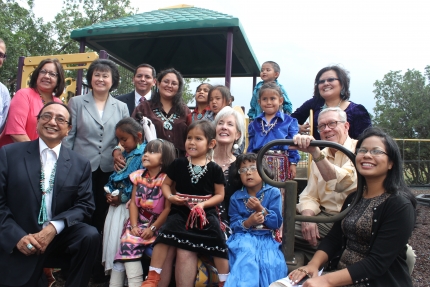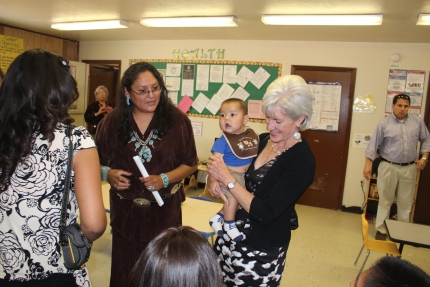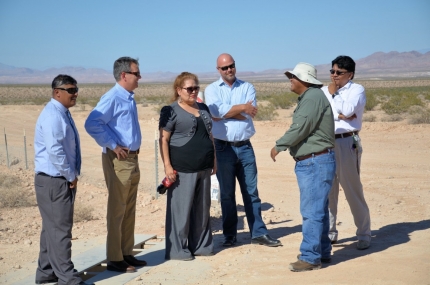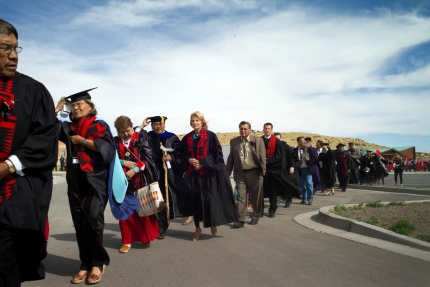Blog Posts Related to the Native American Community
The Affordable Care Act and American Indians and Alaska Natives
Posted by on August 22, 2013 at 4:09 PM ESTEd. note: This is cross-posted from the HHS Blog.
I get questions all the time from American Indians and Alaska Natives (including my own relatives!) wondering why they should care about the Affordable Care Act since they already are eligible for the Indian Health Service (IHS). My response is that while the IHS is here to stay and will be available as their healthcare system, the Affordable Care Act brings new options for health coverage. It is another way that the federal government meets its responsibility to provide health care for American Indians and Alaska Natives.
The purpose of the Affordable Care Act is to increase access to quality health coverage for all Americans, including our First Americans. The benefits of the health care law for American Indians and Alaska Natives are significant whether they have insurance now, want to purchase affordable insurance through the Health Insurance Marketplace or take advantage of the States expanding Medicaid starting in 2014. Indian elders will benefit from a stronger Medicare with more affordable prescriptions and free preventive services no matter what provider they see. And of course, we're thrilled that the Indian Health Care Improvement Act (IHCIA), our authorizing legislation, was made permanent by the Affordable Care Act.
These new benefits mean potentially more services for individuals and the communities we serve. So we are encouraging every American Indian and Alaska Native to enroll in the Marketplaces starting October 1, 2013 to see what benefits are available to them.
To learn more about how the law is benefiting our community visit: http://www.hhs.gov/healthcare/facts/factsheets/2011/03/americanindianhealth03212011a.html
To learn more about the Health Insurance Marketplace visit HealthCare.gov.
Dr. Yvette Roubideaux is the Acting Director of the Indian Health Service.
Learn more about Health CareHealthy Baby, Happy Baby: The Indian Health Service Announces Designation of Two Baby-Friendly Hospitals
Posted by on July 26, 2013 at 10:20 AM ESTEd. note: This is cross-posted from the Let's Move! blog.
The Baby-Friendly Hospital Initiative is a global program that was launched by the World Health Organization (WHO) and the United Nations Children’s Fund (UNICEF) in 1991 to encourage and recognize hospitals and birthing centers that offer an optimal level of care for infant feeding and mother/baby bonding. As part of Let’s Move! in Indian Country, the Indian Health Service (IHS) has committed to certifying all IHS hospitals as Baby-Friendly by the end of 2014, and is proud to announce that to date, five of our facilities are now certified as Baby-Friendly.
Claremore Indian Hospital in Oklahoma and the Phoenix Indian Medical Center in Arizona are the first hospitals in their respective states to receive this prestigious designation. Three other IHS facilities — the Quentin N. Burdick Memorial Health Care Facility, Pine Ridge Hospital, and Rosebud Indian Hospital — received their certification in December 2012 and are the only hospitals in North and South Dakota to be designated as Baby-Friendly.
Improving health in early childhood is a critical pillar of the Let’s Move! initiative. IHS is working to reduce the risk that children will develop obesity and diabetes in the future by supporting new parents who choose to breastfeed.
The Indian Health Service (IHS) is the primary federal health care provider for American Indians and Alaska Natives throughout Indian Country. In June 2011, IHS started its Baby-Friendly Hospital Initiative to give clinicians the tools and information needed to support mothers who choose to breastfeed, giving those mothers information, confidence, and skills.
We are committed to making all our obstetric hospitals Baby-Friendly. We are pleased and proud that IHS hospitals are setting the standard for maternity care in so many states. Our work shows how this initiative can succeed in populations that will most benefit from the Baby-Friendly Hospital Initiative.
Yvette Roubideaux, M.D., M.P.H., is the Acting Director of Indian Health Service, the Federal Health Program for American Indians and Alaska Natives.
Learn more about Health CareStrengthening Health Care in Indian Country
Posted by on July 19, 2013 at 5:24 PM ESTI recently had the honor of visiting leaders and members of the Navajo Nation in Arizona. Their hospitality and kindness speak to the best values of the Navajo culture and traditions. And they, like tribes across the country, are critical partners in the Administration’s efforts to promote the health and well-being of all Americans.
At the Sawmill Head Start Program and local Boys and Girls Club, I saw how local educators are helping prepare young American Indian children to succeed in school and pursue their dreams. On a tour of the Navajo Special Diabetes Program for Indians Wellness Center, I saw dedicated caretakers work to prevent and manage a disease that affects too many on and off the reservations. During a visit to a Tribal elder’s home, I gained a greater understanding of ways we can improve living conditions for all families in the Navajo Nation.
And I was especially proud of the great effort by the staff of the Gallup Indian Medical Center, who recently achieved a Level III Trauma Center designation – a first for the Indian Health Service (IHS). The work of the IHS at this facility, and throughout Indian Country, saves countless lives. That’s why since day one of this Administration, improving the IHS has been a top priority.
In fact, we’ve done more to modernize the IHS and advance overall health in Indian Country in President Obama’s first term than has been done in years. We have increased the IHS budget by almost a third, which is helping improve access to needed services.
Another critical step forward is implementing the Affordable Care Act, which contains many important benefits for American Indians and Alaska Natives. First and foremost, it includes the permanent reauthorization of the Indian Health Care Improvement Act, ensuring that the IHS is here to stay. It also improves benefits and protections for American Indians and Alaska Natives who have insurance, whether they receive care inside or outside the IHS. And it gives them more choices for health coverage, including Medicaid and the Federal Employees Health Benefits Program.
Learn more about Health CareSBA Signs Symbolic Alliance with the Native American Contractors Association
Posted by on July 10, 2013 at 8:12 AM ESTEd note: This is cross-posted from the SBA blog.
The U.S. Small Business Administration and the Native American Contractors Association (NACA) have signed a strategic alliance memorandum to widen our reach to Native American entrepreneurs and boost entrepreneurship opportunities.
SBA continues to work to impact our Native American small business owners. This alliance strengthens both our organizations’ goals: supporting the creation, development and expansion of small businesses in the American Indian, Alaska Native and Native Hawaiian communities.
NACA promotes the common interests of Tribally-owned corporations, Native Hawaiian Organizations (NHO), and Alaska Native Corporations (ANC), and also promotes the benefits of using Native-owned firms with high quality products and services in the federal marketplace and supports the SBA’s 8(a) Business Development Program. In addition, NACA monitors federal economic and business development policies and utilizes their member driven perspective to advocate on their behalf.
By combining our resources with NACA, we can continue to spur new business growth and innovation for the nearly 240,000 Native American-owned small businesses. I want to thank NACA for their commitment to this effort as we work to strengthen and expand small business development within the Native American business community.
In my last blog I said that SBA will continue our focus to strengthen our education and training for Native American-owned businesses, and we are doing just that.
In June, the SBA’s Office of Native American Affairs visited the city of Barrow, Alaska, which is one of the northernmost communities in the United States. We had a chance to talk with the leaders of the Alaska Native Village Corporation, who shared great ideas for improving and building tribal businesses in Northern Alaska.
And in May former Deputy Administrator Marie Johns, Region 8 Administrator Matt Varilek and I visited Sisseton-Wahpeton Oyate of the Lake Traverse Reservation in North East South Dakota. We talked with tribal leadership and with various tribal departments including economic development and planning about innovation entrepreneurship.
In May I also had the privilege to participate in a small business roundtable hosted by the Navajo Nation in New Mexico. We met with small business owners to talk about regulatory fairness, contracting and entrepreneurial development.
The signing of the alliance, as well as our tribal visits are examples of SBA’s proactive outreach to rural Native communities in an effort to support business growth and tribal enterprises by providing the needed tools and resources.
As a result, SBA will be adding entrepreneurship training and development workshops to both the Lake Traverse Reservation and Navajo Nation.
Christopher L. James is assistant administrator for the Office of Native American Affairs at the U.S. Small Business Administration.
Learn more aboutStrengthening our Federal Partnership with Tribal Nations
Posted by on June 27, 2013 at 12:30 PM ESTThis week represents another important step forward in the nation-to-nation relationship between Indian Country and this Administration. Yesterday, President Obama signed an Executive Order establishing a White House Council on Native American Affairs, which will help to continue to strengthen our federal partnership with Tribal Nations.
As Secretary of the Interior, I am honored to chair this Council, which will bring together federal departments and offices on a regular basis to support tribes as they tackle pressing issues such as high unemployment, educational achievement and poverty rates. By further improving interagency coordination and efficiency, the Council will help break down silos and expand existing efforts to leverage federal programs and resources available to tribal communities.
Throughout the year, the Council will work collaboratively toward advancing five priorities that mirror the issues tribal leaders have raised during previous White House Tribal Nations Conferences:
1) Promoting sustainable economic development;
2) Supporting greater access to and control over healthcare;
3) Improving the effectiveness and efficiency of tribal justice systems;
4) Expanding and improving educational opportunities for Native American youth; and
5) Protecting and supporting the sustainable management of Native lands, environments, and natural resources.Learn more about Additional IssuesResponsibility to Future Generations: Renewable Energy Development on Tribal Lands
Posted by on June 25, 2013 at 5:18 PM ESTToday, the President announced his comprehensive plan to cut the carbon pollution that is changing our climate and affecting public health. Reducing carbon pollution will keep our air and water clean and safe for our kids and grandkids. It will also create jobs in the industries of the future as we modernize our power plants to produce cleaner forms of American-made energy that reduce our dependence on foreign oil. And it will lower home energy bills and begin to slow the effects of climate change.
While no single step can reverse the effects of climate change, we need to begin preparing to leave a safe and clean planet to our children. Last weekend, in the desert northeast of Las Vegas, Nevada, I had the privilege of visiting a project that is already working to meet the challenges laid out today in the President's Climate Action Plan. The intense desert heat and bright sun made it crystal clear to anyone who stepped outside that this location has plenty of solar energy to harness.
The Moapa Solar Project, on the Moapa River Indian Reservation, is a 350 megawatt solar energy project that will help power over 100,000 homes and generate 400 jobs at peak construction. The Moapa Paiute tribe has set aside approximately 2,000 acres of their 72,000 acre Reservation for the project, including some acreage to ensure a protected habitat for the endangered desert tortoises living near the project. A commitment to protect their tribal homelands from the effects of existing power sources led this tribe to gain approval from the Secretary of the Interior in 2012 for construction of the first utility-scale solar project on tribal lands. As part of the President's all-of-the-above energy strategy, the Moapa Solar project will help reduce our dependence on foreign oil while creating good jobs in the heart of Indian Country - jobs that can’t be shipped overseas.
Learn more about Energy and EnvironmentCelebrating and Supporting Native Fathers
Posted by on June 10, 2013 at 2:09 PM ESTEd. note: This is cross-posted from the Administration for Children & Families' Blog
ACF’s vision for fatherhood is that every parent is actively engaged in his child’s healthy development, and intellectual, emotional and financial well-being. Strengthening and supporting families is the mission critical effort to all of the programs that ACF operates from Head Start to TANF, to the Office of Child Support.
Research tells us that children thrive and develop to the best of their abilities when the adult in their lives are doing well. For Native American children, there is an additional layer of historical trauma that can interfere with children’s emotional and intellectual development. ANA’s mission of promoting cultural preservation and self-sufficiency makes ANA uniquely suited to provide support to communities for Native fatherhood initiatives.
Earlier this year ANA was able to partner with ACF Region X Office and the ANA Alaska Technical Assistance Center to support the 2013 Alaska Native Fatherhood Summit, read more about that event we blogged about in February. We also hosted a webinar recently about the Aha Kane movement in Hawaii, and how the return to cultural teachings and traditions for Native Hawaiian men is restoring their self-esteem and mental health.
The capacity to be a responsible father or mother is formed over a lifetime, and many of ANA’s grants contribute to a healthier community and improved learning and economic opportunities that create an improved environment that supports family self sufficiency.
For example the Minneapolis American Indian Circle of Generations aims to reduce the intergenerational involvement in the child welfare system through the use of cultural teachings. They host an elder’s lodge, conduct monthly cultural activity groups that form a support network, and provide case management that connects parents to resources and services to create a healthy and supportive home life.
Many ANA projects, like the White Earth Band of Chippewa’s Healthy Families Healthy Communities project seeks to address the impact of historical trauma and its manifestations through a culturally validated educational program that includes parent mentoring.
In addition to these competitive grants, ANA is working with the Native American Fatherhood and Families Association on a national campaign to promote the importance of fatherhood in Tribal communities in a one-year cooperative agreement. Fathers, according to NAFFA President Al Pooley, are Indian Country’s greatest untapped resource. Using a positive approach, NAFFA encourages fathers to take a leadership role in their families emotionally, spiritually and economically.
As part of this Fatherhood initiative, we are strongly encouraging all Native communities throughout the United States, including American Samoa, Guam, and the Commonwealth of the Northern Mariana Islands to organize events on or around Saturday, June 15, for National Native American Responsible Fatherhood Day to celebrate and promote Fatherhood. Activities can be as simple as a Tribal Proclamation or community barbeque, or as elaborate as a weekend canoeing and camping trip with their children. The purpose of these events is to celebrate and encourage active engagement. They can also be an effective tool to connect fathers and families to community services.
We are especially encouraging Tribal ACF programs and Tribal Housing Authorities to register their participation in local events. Too often our thoughts are focused on what is wrong in our community, and this event is an opportunity to celebrate those that strengthen our communities with their wisdom, skills, generosity and time.
If you want to learn more about ACF Responsible Fatherhood Initiative, ANA’s Strengthening Family Resources, click on the links or visit www.fatherhood.gov
Lillian Sparks, a Lakota woman of the Rosebud and Oglala Sioux Tribes, is the Commissioner of the Administration of Native Americans.
Learn more about Working FamiliesBuilding Opportunities in Indian Country: Congratulations to the Graduates of Navajo Technical College
Posted by on May 22, 2013 at 8:00 AM ESTOn Friday, I had the honor of addressing a class of graduates at Navajo Technical College in Crownpoint, New Mexico. The Navajo Tech graduating Class of 2013 earned certificates in 34 fields that will provide the tools they need to serve their community as teachers, nurses, engineers, mechanics, bankers, chefs and countless other opportunities all made possible by their commitment and dedication to improving themselves through the pursuit of a higher education.
Tribal Colleges and Universities (TCUs) play a key role in President Obama’s educational goal of making the United States home to the best-educated, most competitive workforce in the world. TCUs are critical institutions that build tribal communities, create good jobs across Indian Country, and provide Native Americans with the skills they need to do those jobs.
As a community college teacher, I love seeing what a tremendous difference a community like the one I saw at Navajo Tech can make in the lives of its students.
The impressive class of graduates included veterans like Jerrilene Kenneth, who served in Iraq and Afghanistan as an Army mechanic, before she became the first college graduate in her family with an Associate Degree in Early Childhood Education. It also included Navajo Tech Student of the Year Sherwin Becenti, who dropped out of college more than ten years ago but returned to school in order to build a better life for his family and set a good example for his children. Dwight Carlston, who grew up with no running water or electricity, was also among the graduates. Dwight maintained a 3.8 grade point average, ran cross country, served as Student Senate President and was recently elected as the Student Congress president of all 38 tribal colleges.
Learn more about , Education
- &lsaquo previous
- …
- 2
- 3
- 4
- 5
- 6
- 7
- 8
- 9
- 10
- …
- next &rsaquo



